Challenges and Solutions for Full Duplex Wireless in 5G Networks
VerifiedAdded on 2022/11/15
|13
|3107
|437
Report
AI Summary
This report examines the evolution of wireless communication from simplex to duplex systems, focusing on the advancements and challenges in 5G networks. It delves into the complexities of Full Duplex (FD) communication, contrasting it with Time Division Duplexing (TDD) and Frequency Division Duplexing (FDD). The report highlights the advantages of FD, such as increased data rates and reduced latency, while also addressing the critical issues of self-interference cancellation, imperfect interference cancellation, and increased complexity. It explores various FD techniques including full duplex device-to-device (D2D) communication and networking implications. The report discusses the role of different duplexing methods in 5G, emphasizing the need for a flexible blend of techniques to meet diverse application requirements. The report references various research papers and white papers to support the analysis and offers a comprehensive overview of the current state and future prospects of FD in 5G wireless systems. The report also includes the challenges and solutions encountered in implementing full-duplex communications in future PCS and 5G systems.
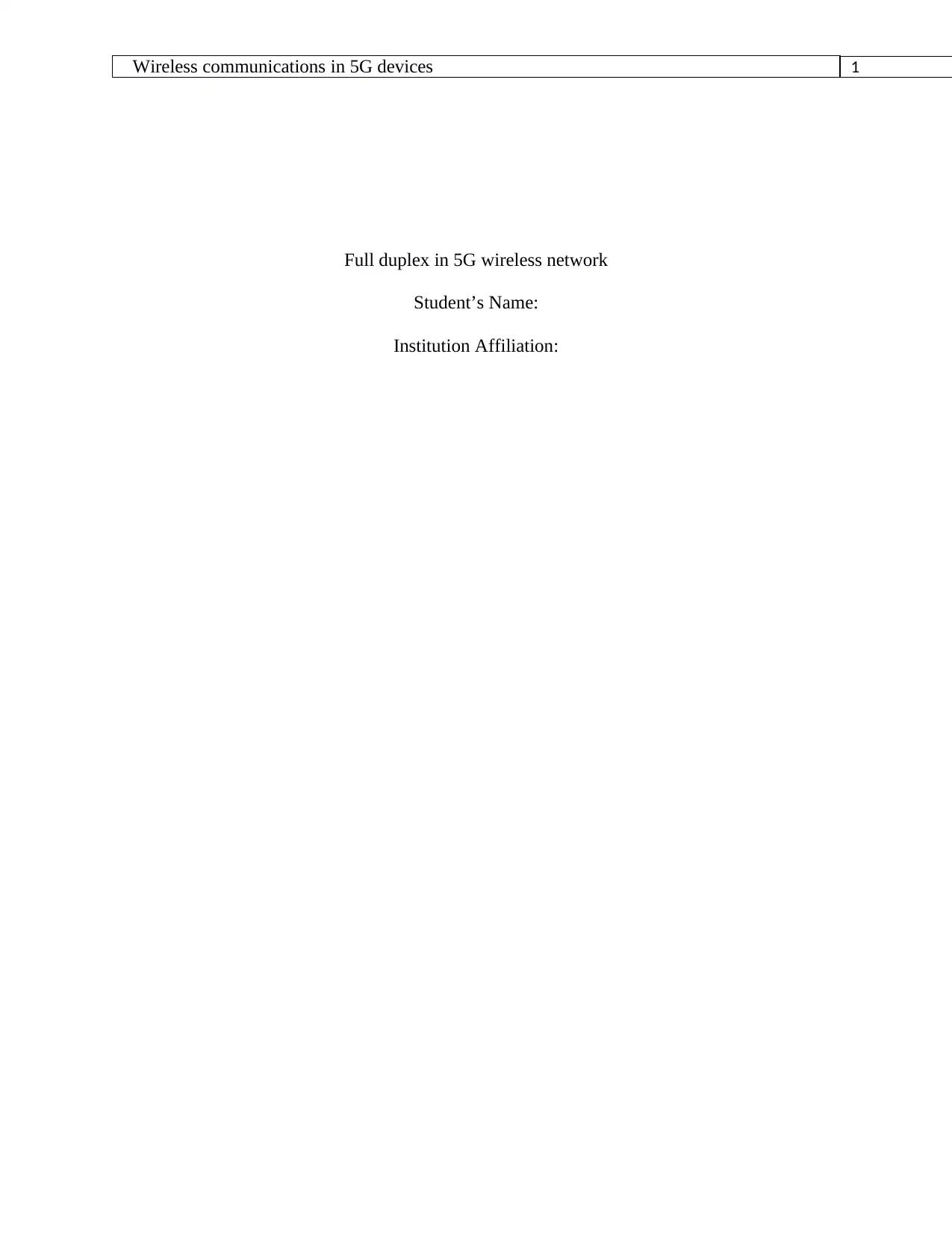
1Wireless communications in 5G devices
in 5G Networks
Full duplex in 5G wireless network
Student’s Name:
Institution Affiliation:
in 5G Networks
Full duplex in 5G wireless network
Student’s Name:
Institution Affiliation:
Paraphrase This Document
Need a fresh take? Get an instant paraphrase of this document with our AI Paraphraser
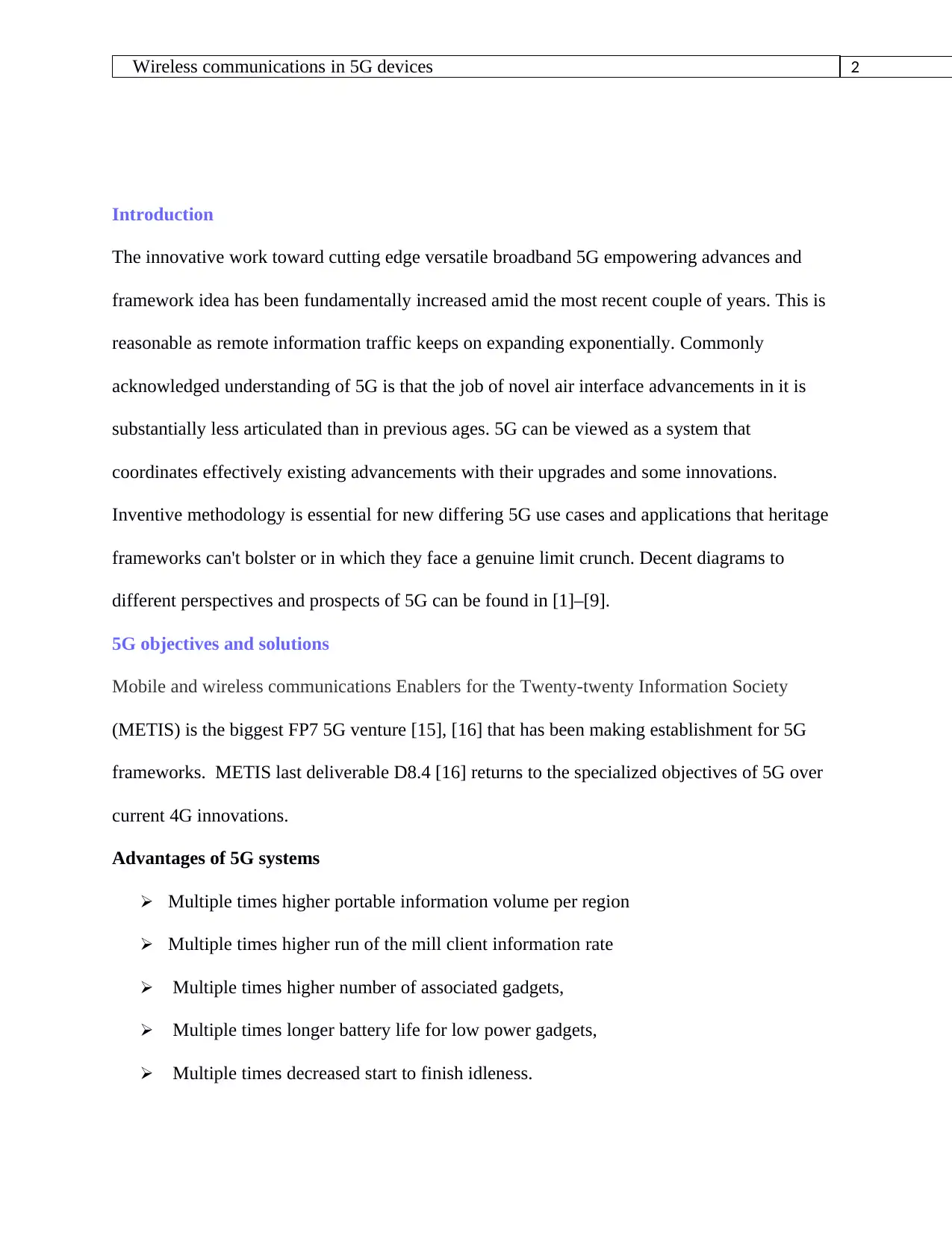
2Wireless communications in 5G devices
in 5G Networks
Introduction
The innovative work toward cutting edge versatile broadband 5G empowering advances and
framework idea has been fundamentally increased amid the most recent couple of years. This is
reasonable as remote information traffic keeps on expanding exponentially. Commonly
acknowledged understanding of 5G is that the job of novel air interface advancements in it is
substantially less articulated than in previous ages. 5G can be viewed as a system that
coordinates effectively existing advancements with their upgrades and some innovations.
Inventive methodology is essential for new differing 5G use cases and applications that heritage
frameworks can't bolster or in which they face a genuine limit crunch. Decent diagrams to
different perspectives and prospects of 5G can be found in [1]–[9].
5G objectives and solutions
Mobile and wireless communications Enablers for the Twenty-twenty Information Society
(METIS) is the biggest FP7 5G venture [15], [16] that has been making establishment for 5G
frameworks. METIS last deliverable D8.4 [16] returns to the specialized objectives of 5G over
current 4G innovations.
Advantages of 5G systems
Multiple times higher portable information volume per region
Multiple times higher run of the mill client information rate
Multiple times higher number of associated gadgets,
Multiple times longer battery life for low power gadgets,
Multiple times decreased start to finish idleness.
in 5G Networks
Introduction
The innovative work toward cutting edge versatile broadband 5G empowering advances and
framework idea has been fundamentally increased amid the most recent couple of years. This is
reasonable as remote information traffic keeps on expanding exponentially. Commonly
acknowledged understanding of 5G is that the job of novel air interface advancements in it is
substantially less articulated than in previous ages. 5G can be viewed as a system that
coordinates effectively existing advancements with their upgrades and some innovations.
Inventive methodology is essential for new differing 5G use cases and applications that heritage
frameworks can't bolster or in which they face a genuine limit crunch. Decent diagrams to
different perspectives and prospects of 5G can be found in [1]–[9].
5G objectives and solutions
Mobile and wireless communications Enablers for the Twenty-twenty Information Society
(METIS) is the biggest FP7 5G venture [15], [16] that has been making establishment for 5G
frameworks. METIS last deliverable D8.4 [16] returns to the specialized objectives of 5G over
current 4G innovations.
Advantages of 5G systems
Multiple times higher portable information volume per region
Multiple times higher run of the mill client information rate
Multiple times higher number of associated gadgets,
Multiple times longer battery life for low power gadgets,
Multiple times decreased start to finish idleness.
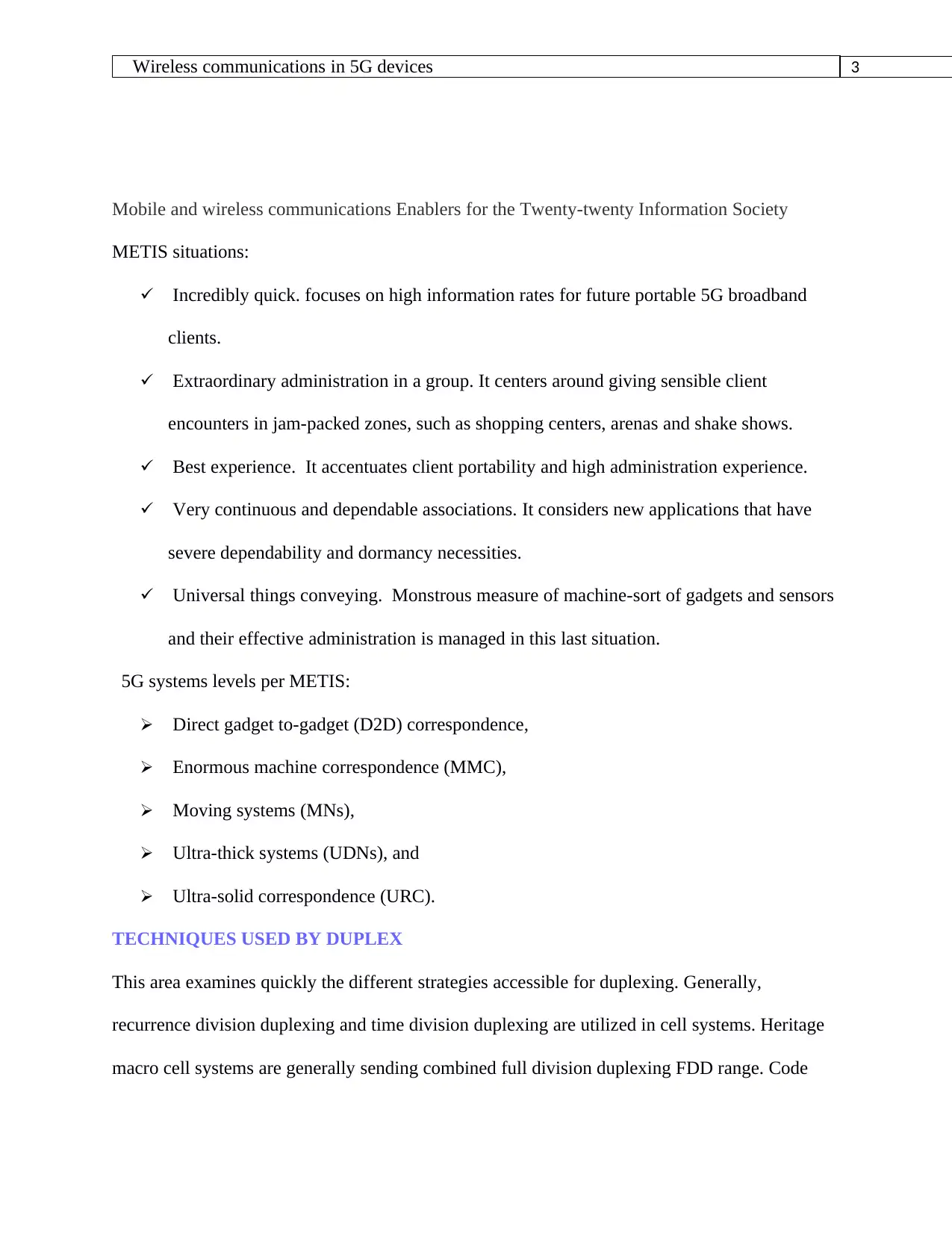
3Wireless communications in 5G devices
in 5G Networks
Mobile and wireless communications Enablers for the Twenty-twenty Information Society
METIS situations:
Incredibly quick. focuses on high information rates for future portable 5G broadband
clients.
Extraordinary administration in a group. It centers around giving sensible client
encounters in jam-packed zones, such as shopping centers, arenas and shake shows.
Best experience. It accentuates client portability and high administration experience.
Very continuous and dependable associations. It considers new applications that have
severe dependability and dormancy necessities.
Universal things conveying. Monstrous measure of machine-sort of gadgets and sensors
and their effective administration is managed in this last situation.
5G systems levels per METIS:
Direct gadget to-gadget (D2D) correspondence,
Enormous machine correspondence (MMC),
Moving systems (MNs),
Ultra-thick systems (UDNs), and
Ultra-solid correspondence (URC).
TECHNIQUES USED BY DUPLEX
This area examines quickly the different strategies accessible for duplexing. Generally,
recurrence division duplexing and time division duplexing are utilized in cell systems. Heritage
macro cell systems are generally sending combined full division duplexing FDD range. Code
in 5G Networks
Mobile and wireless communications Enablers for the Twenty-twenty Information Society
METIS situations:
Incredibly quick. focuses on high information rates for future portable 5G broadband
clients.
Extraordinary administration in a group. It centers around giving sensible client
encounters in jam-packed zones, such as shopping centers, arenas and shake shows.
Best experience. It accentuates client portability and high administration experience.
Very continuous and dependable associations. It considers new applications that have
severe dependability and dormancy necessities.
Universal things conveying. Monstrous measure of machine-sort of gadgets and sensors
and their effective administration is managed in this last situation.
5G systems levels per METIS:
Direct gadget to-gadget (D2D) correspondence,
Enormous machine correspondence (MMC),
Moving systems (MNs),
Ultra-thick systems (UDNs), and
Ultra-solid correspondence (URC).
TECHNIQUES USED BY DUPLEX
This area examines quickly the different strategies accessible for duplexing. Generally,
recurrence division duplexing and time division duplexing are utilized in cell systems. Heritage
macro cell systems are generally sending combined full division duplexing FDD range. Code
⊘ This is a preview!⊘
Do you want full access?
Subscribe today to unlock all pages.

Trusted by 1+ million students worldwide
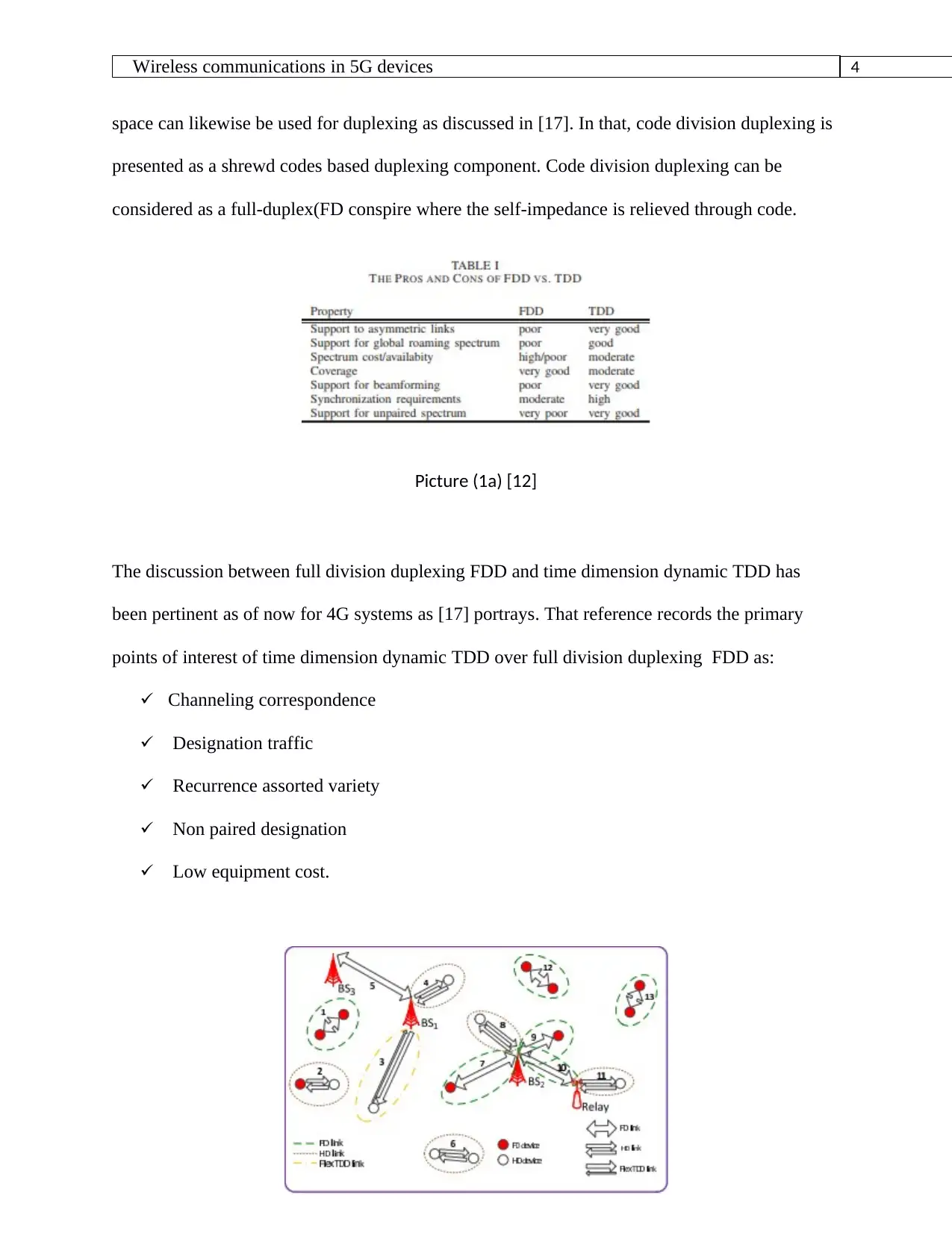
4Wireless communications in 5G devices
in 5G Networks
space can likewise be used for duplexing as discussed in [17]. In that, code division duplexing is
presented as a shrewd codes based duplexing component. Code division duplexing can be
considered as a full-duplex(FD conspire where the self-impedance is relieved through code.
Picture (1a) [12]
The discussion between full division duplexing FDD and time dimension dynamic TDD has
been pertinent as of now for 4G systems as [17] portrays. That reference records the primary
points of interest of time dimension dynamic TDD over full division duplexing FDD as:
Channeling correspondence
Designation traffic
Recurrence assorted variety
Non paired designation
Low equipment cost.
in 5G Networks
space can likewise be used for duplexing as discussed in [17]. In that, code division duplexing is
presented as a shrewd codes based duplexing component. Code division duplexing can be
considered as a full-duplex(FD conspire where the self-impedance is relieved through code.
Picture (1a) [12]
The discussion between full division duplexing FDD and time dimension dynamic TDD has
been pertinent as of now for 4G systems as [17] portrays. That reference records the primary
points of interest of time dimension dynamic TDD over full division duplexing FDD as:
Channeling correspondence
Designation traffic
Recurrence assorted variety
Non paired designation
Low equipment cost.
Paraphrase This Document
Need a fresh take? Get an instant paraphrase of this document with our AI Paraphraser

5Wireless communications in 5G devices
in 5G Networks
Picture (1b) [9]
Overview of full duplexing
Reference [26] gives an exhaustive study of physical and Macintosh layer full duplexing FD
achievements in different remote system topology subjects inside them. Advantages of full
duplex are:
Twofold ergodic limit,
Lessen input delay,
Diminish start to finish delay,
Improve arrange mystery,
Effectiveness of specially appointed system conventions, e.g., settling 'concealed hub'
issue, and
Can expand range use adaptability.
The disadvantages are:
Self-impedance (SI),
Flawed impedance crossing out,
Expanded between client obstruction, what's more,
Expanded power utilization and multifaceted nature.
Full duplexing
Transferring has been one of the first and generally seriously contemplated functionalities for
in 5G Networks
Picture (1b) [9]
Overview of full duplexing
Reference [26] gives an exhaustive study of physical and Macintosh layer full duplexing FD
achievements in different remote system topology subjects inside them. Advantages of full
duplex are:
Twofold ergodic limit,
Lessen input delay,
Diminish start to finish delay,
Improve arrange mystery,
Effectiveness of specially appointed system conventions, e.g., settling 'concealed hub'
issue, and
Can expand range use adaptability.
The disadvantages are:
Self-impedance (SI),
Flawed impedance crossing out,
Expanded between client obstruction, what's more,
Expanded power utilization and multifaceted nature.
Full duplexing
Transferring has been one of the first and generally seriously contemplated functionalities for
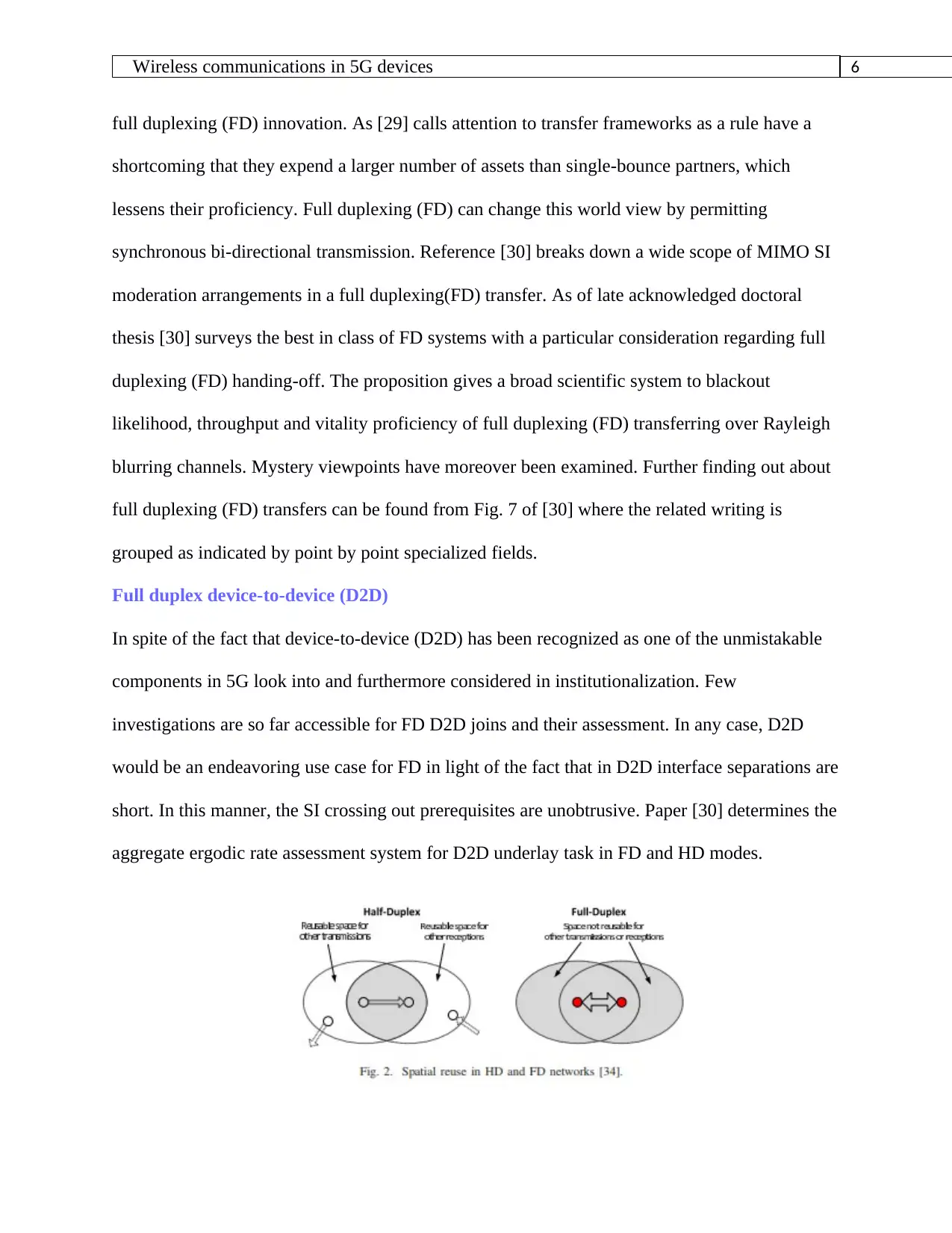
6Wireless communications in 5G devices
in 5G Networks
full duplexing (FD) innovation. As [29] calls attention to transfer frameworks as a rule have a
shortcoming that they expend a larger number of assets than single-bounce partners, which
lessens their proficiency. Full duplexing (FD) can change this world view by permitting
synchronous bi-directional transmission. Reference [30] breaks down a wide scope of MIMO SI
moderation arrangements in a full duplexing(FD) transfer. As of late acknowledged doctoral
thesis [30] surveys the best in class of FD systems with a particular consideration regarding full
duplexing (FD) handing-off. The proposition gives a broad scientific system to blackout
likelihood, throughput and vitality proficiency of full duplexing (FD) transferring over Rayleigh
blurring channels. Mystery viewpoints have moreover been examined. Further finding out about
full duplexing (FD) transfers can be found from Fig. 7 of [30] where the related writing is
grouped as indicated by point by point specialized fields.
Full duplex device-to-device (D2D)
In spite of the fact that device-to-device (D2D) has been recognized as one of the unmistakable
components in 5G look into and furthermore considered in institutionalization. Few
investigations are so far accessible for FD D2D joins and their assessment. In any case, D2D
would be an endeavoring use case for FD in light of the fact that in D2D interface separations are
short. In this manner, the SI crossing out prerequisites are unobtrusive. Paper [30] determines the
aggregate ergodic rate assessment system for D2D underlay task in FD and HD modes.
in 5G Networks
full duplexing (FD) innovation. As [29] calls attention to transfer frameworks as a rule have a
shortcoming that they expend a larger number of assets than single-bounce partners, which
lessens their proficiency. Full duplexing (FD) can change this world view by permitting
synchronous bi-directional transmission. Reference [30] breaks down a wide scope of MIMO SI
moderation arrangements in a full duplexing(FD) transfer. As of late acknowledged doctoral
thesis [30] surveys the best in class of FD systems with a particular consideration regarding full
duplexing (FD) handing-off. The proposition gives a broad scientific system to blackout
likelihood, throughput and vitality proficiency of full duplexing (FD) transferring over Rayleigh
blurring channels. Mystery viewpoints have moreover been examined. Further finding out about
full duplexing (FD) transfers can be found from Fig. 7 of [30] where the related writing is
grouped as indicated by point by point specialized fields.
Full duplex device-to-device (D2D)
In spite of the fact that device-to-device (D2D) has been recognized as one of the unmistakable
components in 5G look into and furthermore considered in institutionalization. Few
investigations are so far accessible for FD D2D joins and their assessment. In any case, D2D
would be an endeavoring use case for FD in light of the fact that in D2D interface separations are
short. In this manner, the SI crossing out prerequisites are unobtrusive. Paper [30] determines the
aggregate ergodic rate assessment system for D2D underlay task in FD and HD modes.
⊘ This is a preview!⊘
Do you want full access?
Subscribe today to unlock all pages.

Trusted by 1+ million students worldwide

7Wireless communications in 5G devices
in 5G Networks
Networking in full duplex
Most of existing FD writing is identified with person joins and their different angles depicted
previously. Be that as it may, another intriguing inquiry is the way the potential connection level
additions transform into multi-get to or organizing level increases. References [30] and [31]
address this inquiry. The previous closes that FD radios can't twofold the system limit (even
within the sight of flawless self-impedance retraction) due to spatial reuse and offbeat dispute
impacts. The contrasts in HD and FD spatial reuse are represented in Fig. 3 where it very well
may be noticed that dynamic FD task involves more space than HD for non-meddling task by
neighboring joins. The last arrives at an equivalent by and large end appearing 35% – 45% mean
throughput gains in inside full cushion traffic setting. In that review near twofold throughput was
just reachable when the cells were secluded by enormous divider infiltration misfortunes
Discussion
Simplex transmission is straightforward and for instance TV communicate may keep on working
in this style likewise in close future. Be that as it may, the greater part of the utilization cases and
applications require bi-directionality and in this manner duplexing. FDD has an overwhelming
job in huge inclusion region remote cell systems. Matched FDD frequencies have ordinarily been
authorized to portable administrators with high speculations. In this manner, the life expectancy
of FDD frameworks at low frequencies is probably going to reach out far later on. This implies
FDD stays to be the main pervasive inclusion giving duplexing procedure additionally in the 5G
time.
Conclusion
in 5G Networks
Networking in full duplex
Most of existing FD writing is identified with person joins and their different angles depicted
previously. Be that as it may, another intriguing inquiry is the way the potential connection level
additions transform into multi-get to or organizing level increases. References [30] and [31]
address this inquiry. The previous closes that FD radios can't twofold the system limit (even
within the sight of flawless self-impedance retraction) due to spatial reuse and offbeat dispute
impacts. The contrasts in HD and FD spatial reuse are represented in Fig. 3 where it very well
may be noticed that dynamic FD task involves more space than HD for non-meddling task by
neighboring joins. The last arrives at an equivalent by and large end appearing 35% – 45% mean
throughput gains in inside full cushion traffic setting. In that review near twofold throughput was
just reachable when the cells were secluded by enormous divider infiltration misfortunes
Discussion
Simplex transmission is straightforward and for instance TV communicate may keep on working
in this style likewise in close future. Be that as it may, the greater part of the utilization cases and
applications require bi-directionality and in this manner duplexing. FDD has an overwhelming
job in huge inclusion region remote cell systems. Matched FDD frequencies have ordinarily been
authorized to portable administrators with high speculations. In this manner, the life expectancy
of FDD frameworks at low frequencies is probably going to reach out far later on. This implies
FDD stays to be the main pervasive inclusion giving duplexing procedure additionally in the 5G
time.
Conclusion
Paraphrase This Document
Need a fresh take? Get an instant paraphrase of this document with our AI Paraphraser

8Wireless communications in 5G devices
in 5G Networks
A diagram of various duplexing alternatives and their job in 5G advancement was given.
Beginning from heritage macro cell FDD method the ongoing patterns have driven little cell
TDD also, FD systems and their cross breeds. These progressively deft and limit boosting
innovations are significant segments in quest for testing 5G targets. Adaptable and dynamic TDD
is as of now a feasible choice for changing the link for downloading requests superior to fixed
FDD or TDD can. FD will be a further improvement yet has still numerous uncertain issues
particularly in multi-get to and organizing zone. Progressed duplexing systems will have a huge
job in 5G organize engineering structure. Because of huge assorted variety of anticipated 5G
situations and applications it appears glaringly evident that a flexible blend of various duplex
methods is without a doubt required in 5G.
Reference
[1] J. G. Andrews, S. Buzzi, W. Choi, S. V. Hanly, A. Lozano, A. C. K. Soong, and J. C. Zhang,
“What will 5G be?” IEEE J. Sel. Areas Commun., vol. 32, pp. 1065–1082, Jun. 2014.
[2] E. Dahlman, G. Mildh, S. Parkvall, J. Sachs, and Y. Sel´en, “5G radio access,” Ericsson
in 5G Networks
A diagram of various duplexing alternatives and their job in 5G advancement was given.
Beginning from heritage macro cell FDD method the ongoing patterns have driven little cell
TDD also, FD systems and their cross breeds. These progressively deft and limit boosting
innovations are significant segments in quest for testing 5G targets. Adaptable and dynamic TDD
is as of now a feasible choice for changing the link for downloading requests superior to fixed
FDD or TDD can. FD will be a further improvement yet has still numerous uncertain issues
particularly in multi-get to and organizing zone. Progressed duplexing systems will have a huge
job in 5G organize engineering structure. Because of huge assorted variety of anticipated 5G
situations and applications it appears glaringly evident that a flexible blend of various duplex
methods is without a doubt required in 5G.
Reference
[1] J. G. Andrews, S. Buzzi, W. Choi, S. V. Hanly, A. Lozano, A. C. K. Soong, and J. C. Zhang,
“What will 5G be?” IEEE J. Sel. Areas Commun., vol. 32, pp. 1065–1082, Jun. 2014.
[2] E. Dahlman, G. Mildh, S. Parkvall, J. Sachs, and Y. Sel´en, “5G radio access,” Ericsson

9Wireless communications in 5G devices
in 5G Networks
Review, p. 8, Jun. 2014.
[3] “4G Americas’ summary of global 5G initiatives,” White Paper, 4G Americas, Jun. 2014.
[Online]. Available: http://www.4gamericas.org/ documents/2014 4GA Summary of Global 5G
Initiatives Final.pdf
[4] “NGNM 5G white paper,” White Paper, NGMN Alliance, Feb. 2015. [Online]. Available:
https://www.ngmn.org/uploads/media/NGMN 5G White Paper V1 0.pdf
[5] “Looking ahead to 5G – building a virtual zero latency gigabit experience,” White Paper,
Nokia Networks, 2014. [Online]. Available: http://
networks.nokia.com/sites/default/files/document/5g white paper 0.pdf
[6] “5G: a technology vision,” White Paper, Huawei, Nov. 2013. [Online]. Available:
http://www.huawei.com/5gwhitepaper
[7] “5G radio access,” White Paper, Ericsson, Feb. 2015. [Online]. Available:
http://www.ericsson.com/res/docs/whitepapers/wp-5g.pdf
[8] “Evolution, converge, and innovation – 5G white paper,” White Paper, Datang Wireless
Mobile Innovation Center, Dec. 2013. [Online]. Available:
http://www.datanggroup.cn/upload/accessory/ 201312/2013129194455265372.pdf
[9] “5G – driving the convergence of the physical and digital worlds,” White Paper, ZTE, Feb.
2014. [Online]. Available: http://wwwen.zte.com.cn/
en/products/bearer/201402/P02014022140221415329571322.pdf
[10] “5G radio access: requirements, concepts and technologies,” White Paper, NTT DOCOMO,
Inc., Jul. 2014. [Online]. Available: https://www.nttdocomo.co.jp/english/binary/pdf/corporate/
technology/whitepaper 5g/DOCOMO 5G White Paper.pdf
[11] V. H. MacDonald, “The cellular concept,” The Bell System Technical Journal, vol. 58, pp.
in 5G Networks
Review, p. 8, Jun. 2014.
[3] “4G Americas’ summary of global 5G initiatives,” White Paper, 4G Americas, Jun. 2014.
[Online]. Available: http://www.4gamericas.org/ documents/2014 4GA Summary of Global 5G
Initiatives Final.pdf
[4] “NGNM 5G white paper,” White Paper, NGMN Alliance, Feb. 2015. [Online]. Available:
https://www.ngmn.org/uploads/media/NGMN 5G White Paper V1 0.pdf
[5] “Looking ahead to 5G – building a virtual zero latency gigabit experience,” White Paper,
Nokia Networks, 2014. [Online]. Available: http://
networks.nokia.com/sites/default/files/document/5g white paper 0.pdf
[6] “5G: a technology vision,” White Paper, Huawei, Nov. 2013. [Online]. Available:
http://www.huawei.com/5gwhitepaper
[7] “5G radio access,” White Paper, Ericsson, Feb. 2015. [Online]. Available:
http://www.ericsson.com/res/docs/whitepapers/wp-5g.pdf
[8] “Evolution, converge, and innovation – 5G white paper,” White Paper, Datang Wireless
Mobile Innovation Center, Dec. 2013. [Online]. Available:
http://www.datanggroup.cn/upload/accessory/ 201312/2013129194455265372.pdf
[9] “5G – driving the convergence of the physical and digital worlds,” White Paper, ZTE, Feb.
2014. [Online]. Available: http://wwwen.zte.com.cn/
en/products/bearer/201402/P02014022140221415329571322.pdf
[10] “5G radio access: requirements, concepts and technologies,” White Paper, NTT DOCOMO,
Inc., Jul. 2014. [Online]. Available: https://www.nttdocomo.co.jp/english/binary/pdf/corporate/
technology/whitepaper 5g/DOCOMO 5G White Paper.pdf
[11] V. H. MacDonald, “The cellular concept,” The Bell System Technical Journal, vol. 58, pp.
⊘ This is a preview!⊘
Do you want full access?
Subscribe today to unlock all pages.

Trusted by 1+ million students worldwide
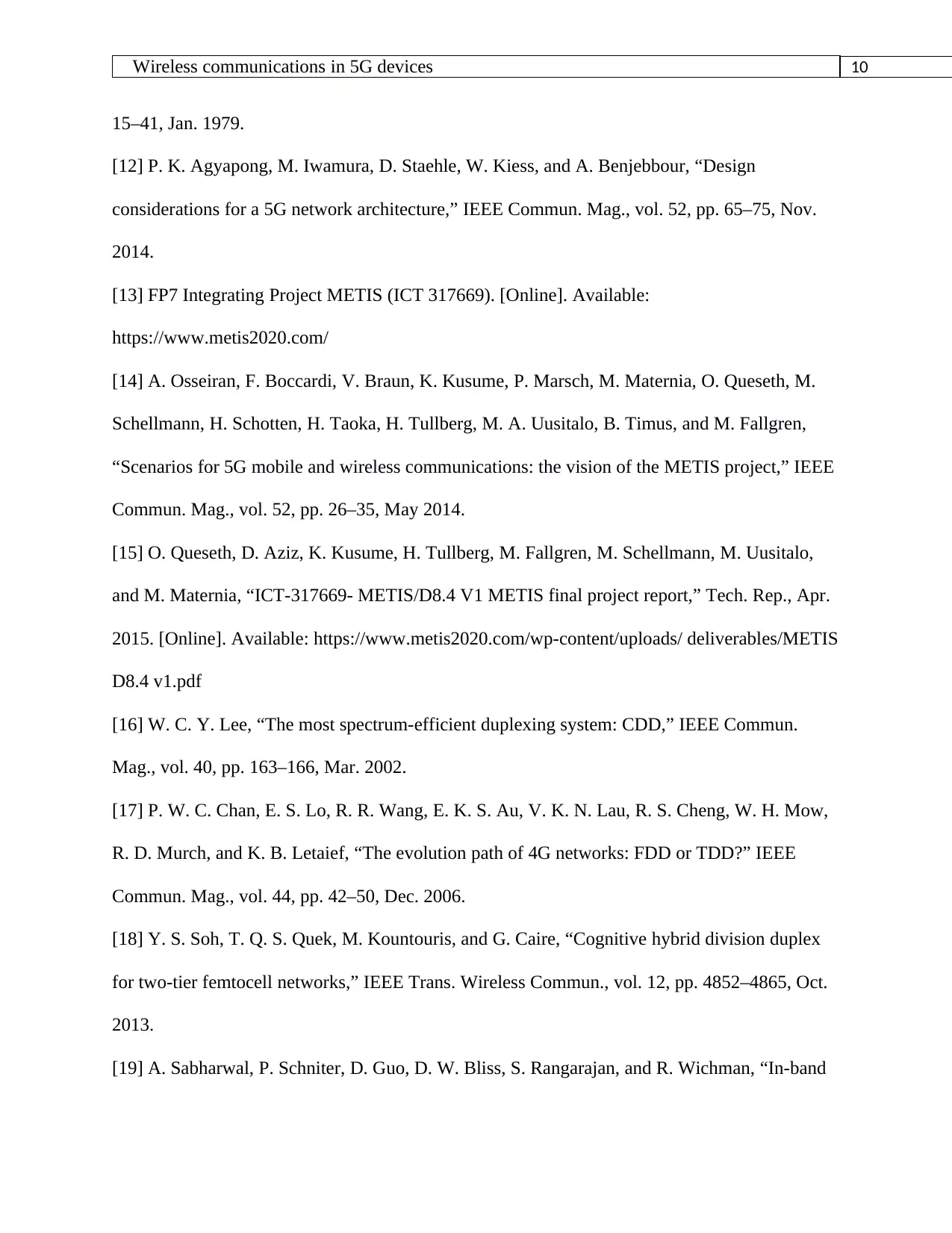
10Wireless communications in 5G devices
in 5G Networks
15–41, Jan. 1979.
[12] P. K. Agyapong, M. Iwamura, D. Staehle, W. Kiess, and A. Benjebbour, “Design
considerations for a 5G network architecture,” IEEE Commun. Mag., vol. 52, pp. 65–75, Nov.
2014.
[13] FP7 Integrating Project METIS (ICT 317669). [Online]. Available:
https://www.metis2020.com/
[14] A. Osseiran, F. Boccardi, V. Braun, K. Kusume, P. Marsch, M. Maternia, O. Queseth, M.
Schellmann, H. Schotten, H. Taoka, H. Tullberg, M. A. Uusitalo, B. Timus, and M. Fallgren,
“Scenarios for 5G mobile and wireless communications: the vision of the METIS project,” IEEE
Commun. Mag., vol. 52, pp. 26–35, May 2014.
[15] O. Queseth, D. Aziz, K. Kusume, H. Tullberg, M. Fallgren, M. Schellmann, M. Uusitalo,
and M. Maternia, “ICT-317669- METIS/D8.4 V1 METIS final project report,” Tech. Rep., Apr.
2015. [Online]. Available: https://www.metis2020.com/wp-content/uploads/ deliverables/METIS
D8.4 v1.pdf
[16] W. C. Y. Lee, “The most spectrum-efficient duplexing system: CDD,” IEEE Commun.
Mag., vol. 40, pp. 163–166, Mar. 2002.
[17] P. W. C. Chan, E. S. Lo, R. R. Wang, E. K. S. Au, V. K. N. Lau, R. S. Cheng, W. H. Mow,
R. D. Murch, and K. B. Letaief, “The evolution path of 4G networks: FDD or TDD?” IEEE
Commun. Mag., vol. 44, pp. 42–50, Dec. 2006.
[18] Y. S. Soh, T. Q. S. Quek, M. Kountouris, and G. Caire, “Cognitive hybrid division duplex
for two-tier femtocell networks,” IEEE Trans. Wireless Commun., vol. 12, pp. 4852–4865, Oct.
2013.
[19] A. Sabharwal, P. Schniter, D. Guo, D. W. Bliss, S. Rangarajan, and R. Wichman, “In-band
in 5G Networks
15–41, Jan. 1979.
[12] P. K. Agyapong, M. Iwamura, D. Staehle, W. Kiess, and A. Benjebbour, “Design
considerations for a 5G network architecture,” IEEE Commun. Mag., vol. 52, pp. 65–75, Nov.
2014.
[13] FP7 Integrating Project METIS (ICT 317669). [Online]. Available:
https://www.metis2020.com/
[14] A. Osseiran, F. Boccardi, V. Braun, K. Kusume, P. Marsch, M. Maternia, O. Queseth, M.
Schellmann, H. Schotten, H. Taoka, H. Tullberg, M. A. Uusitalo, B. Timus, and M. Fallgren,
“Scenarios for 5G mobile and wireless communications: the vision of the METIS project,” IEEE
Commun. Mag., vol. 52, pp. 26–35, May 2014.
[15] O. Queseth, D. Aziz, K. Kusume, H. Tullberg, M. Fallgren, M. Schellmann, M. Uusitalo,
and M. Maternia, “ICT-317669- METIS/D8.4 V1 METIS final project report,” Tech. Rep., Apr.
2015. [Online]. Available: https://www.metis2020.com/wp-content/uploads/ deliverables/METIS
D8.4 v1.pdf
[16] W. C. Y. Lee, “The most spectrum-efficient duplexing system: CDD,” IEEE Commun.
Mag., vol. 40, pp. 163–166, Mar. 2002.
[17] P. W. C. Chan, E. S. Lo, R. R. Wang, E. K. S. Au, V. K. N. Lau, R. S. Cheng, W. H. Mow,
R. D. Murch, and K. B. Letaief, “The evolution path of 4G networks: FDD or TDD?” IEEE
Commun. Mag., vol. 44, pp. 42–50, Dec. 2006.
[18] Y. S. Soh, T. Q. S. Quek, M. Kountouris, and G. Caire, “Cognitive hybrid division duplex
for two-tier femtocell networks,” IEEE Trans. Wireless Commun., vol. 12, pp. 4852–4865, Oct.
2013.
[19] A. Sabharwal, P. Schniter, D. Guo, D. W. Bliss, S. Rangarajan, and R. Wichman, “In-band
Paraphrase This Document
Need a fresh take? Get an instant paraphrase of this document with our AI Paraphraser
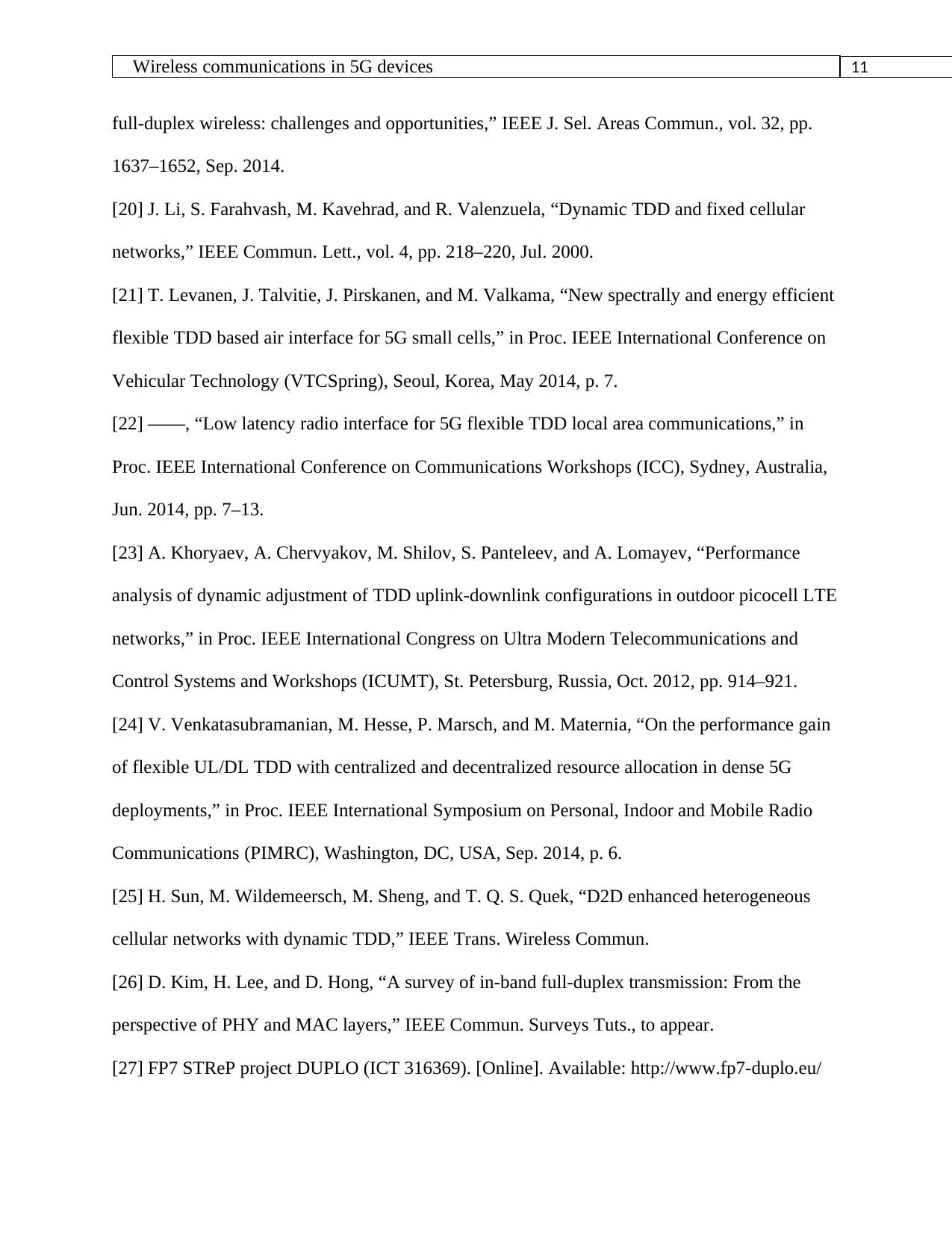
11Wireless communications in 5G devices
in 5G Networks
full-duplex wireless: challenges and opportunities,” IEEE J. Sel. Areas Commun., vol. 32, pp.
1637–1652, Sep. 2014.
[20] J. Li, S. Farahvash, M. Kavehrad, and R. Valenzuela, “Dynamic TDD and fixed cellular
networks,” IEEE Commun. Lett., vol. 4, pp. 218–220, Jul. 2000.
[21] T. Levanen, J. Talvitie, J. Pirskanen, and M. Valkama, “New spectrally and energy efficient
flexible TDD based air interface for 5G small cells,” in Proc. IEEE International Conference on
Vehicular Technology (VTCSpring), Seoul, Korea, May 2014, p. 7.
[22] ——, “Low latency radio interface for 5G flexible TDD local area communications,” in
Proc. IEEE International Conference on Communications Workshops (ICC), Sydney, Australia,
Jun. 2014, pp. 7–13.
[23] A. Khoryaev, A. Chervyakov, M. Shilov, S. Panteleev, and A. Lomayev, “Performance
analysis of dynamic adjustment of TDD uplink-downlink configurations in outdoor picocell LTE
networks,” in Proc. IEEE International Congress on Ultra Modern Telecommunications and
Control Systems and Workshops (ICUMT), St. Petersburg, Russia, Oct. 2012, pp. 914–921.
[24] V. Venkatasubramanian, M. Hesse, P. Marsch, and M. Maternia, “On the performance gain
of flexible UL/DL TDD with centralized and decentralized resource allocation in dense 5G
deployments,” in Proc. IEEE International Symposium on Personal, Indoor and Mobile Radio
Communications (PIMRC), Washington, DC, USA, Sep. 2014, p. 6.
[25] H. Sun, M. Wildemeersch, M. Sheng, and T. Q. S. Quek, “D2D enhanced heterogeneous
cellular networks with dynamic TDD,” IEEE Trans. Wireless Commun.
[26] D. Kim, H. Lee, and D. Hong, “A survey of in-band full-duplex transmission: From the
perspective of PHY and MAC layers,” IEEE Commun. Surveys Tuts., to appear.
[27] FP7 STReP project DUPLO (ICT 316369). [Online]. Available: http://www.fp7-duplo.eu/
in 5G Networks
full-duplex wireless: challenges and opportunities,” IEEE J. Sel. Areas Commun., vol. 32, pp.
1637–1652, Sep. 2014.
[20] J. Li, S. Farahvash, M. Kavehrad, and R. Valenzuela, “Dynamic TDD and fixed cellular
networks,” IEEE Commun. Lett., vol. 4, pp. 218–220, Jul. 2000.
[21] T. Levanen, J. Talvitie, J. Pirskanen, and M. Valkama, “New spectrally and energy efficient
flexible TDD based air interface for 5G small cells,” in Proc. IEEE International Conference on
Vehicular Technology (VTCSpring), Seoul, Korea, May 2014, p. 7.
[22] ——, “Low latency radio interface for 5G flexible TDD local area communications,” in
Proc. IEEE International Conference on Communications Workshops (ICC), Sydney, Australia,
Jun. 2014, pp. 7–13.
[23] A. Khoryaev, A. Chervyakov, M. Shilov, S. Panteleev, and A. Lomayev, “Performance
analysis of dynamic adjustment of TDD uplink-downlink configurations in outdoor picocell LTE
networks,” in Proc. IEEE International Congress on Ultra Modern Telecommunications and
Control Systems and Workshops (ICUMT), St. Petersburg, Russia, Oct. 2012, pp. 914–921.
[24] V. Venkatasubramanian, M. Hesse, P. Marsch, and M. Maternia, “On the performance gain
of flexible UL/DL TDD with centralized and decentralized resource allocation in dense 5G
deployments,” in Proc. IEEE International Symposium on Personal, Indoor and Mobile Radio
Communications (PIMRC), Washington, DC, USA, Sep. 2014, p. 6.
[25] H. Sun, M. Wildemeersch, M. Sheng, and T. Q. S. Quek, “D2D enhanced heterogeneous
cellular networks with dynamic TDD,” IEEE Trans. Wireless Commun.
[26] D. Kim, H. Lee, and D. Hong, “A survey of in-band full-duplex transmission: From the
perspective of PHY and MAC layers,” IEEE Commun. Surveys Tuts., to appear.
[27] FP7 STReP project DUPLO (ICT 316369). [Online]. Available: http://www.fp7-duplo.eu/
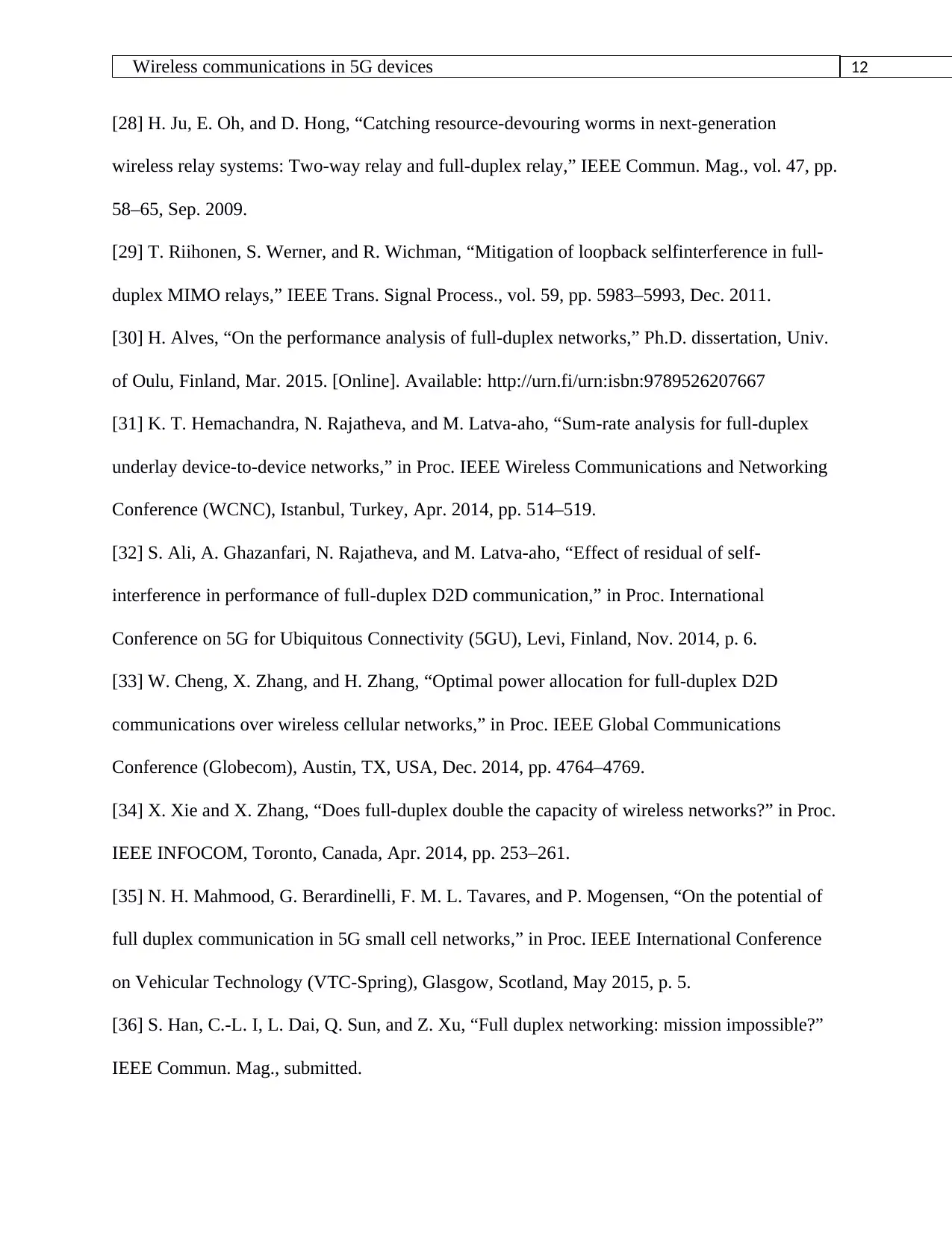
12Wireless communications in 5G devices
in 5G Networks
[28] H. Ju, E. Oh, and D. Hong, “Catching resource-devouring worms in next-generation
wireless relay systems: Two-way relay and full-duplex relay,” IEEE Commun. Mag., vol. 47, pp.
58–65, Sep. 2009.
[29] T. Riihonen, S. Werner, and R. Wichman, “Mitigation of loopback selfinterference in full-
duplex MIMO relays,” IEEE Trans. Signal Process., vol. 59, pp. 5983–5993, Dec. 2011.
[30] H. Alves, “On the performance analysis of full-duplex networks,” Ph.D. dissertation, Univ.
of Oulu, Finland, Mar. 2015. [Online]. Available: http://urn.fi/urn:isbn:9789526207667
[31] K. T. Hemachandra, N. Rajatheva, and M. Latva-aho, “Sum-rate analysis for full-duplex
underlay device-to-device networks,” in Proc. IEEE Wireless Communications and Networking
Conference (WCNC), Istanbul, Turkey, Apr. 2014, pp. 514–519.
[32] S. Ali, A. Ghazanfari, N. Rajatheva, and M. Latva-aho, “Effect of residual of self-
interference in performance of full-duplex D2D communication,” in Proc. International
Conference on 5G for Ubiquitous Connectivity (5GU), Levi, Finland, Nov. 2014, p. 6.
[33] W. Cheng, X. Zhang, and H. Zhang, “Optimal power allocation for full-duplex D2D
communications over wireless cellular networks,” in Proc. IEEE Global Communications
Conference (Globecom), Austin, TX, USA, Dec. 2014, pp. 4764–4769.
[34] X. Xie and X. Zhang, “Does full-duplex double the capacity of wireless networks?” in Proc.
IEEE INFOCOM, Toronto, Canada, Apr. 2014, pp. 253–261.
[35] N. H. Mahmood, G. Berardinelli, F. M. L. Tavares, and P. Mogensen, “On the potential of
full duplex communication in 5G small cell networks,” in Proc. IEEE International Conference
on Vehicular Technology (VTC-Spring), Glasgow, Scotland, May 2015, p. 5.
[36] S. Han, C.-L. I, L. Dai, Q. Sun, and Z. Xu, “Full duplex networking: mission impossible?”
IEEE Commun. Mag., submitted.
in 5G Networks
[28] H. Ju, E. Oh, and D. Hong, “Catching resource-devouring worms in next-generation
wireless relay systems: Two-way relay and full-duplex relay,” IEEE Commun. Mag., vol. 47, pp.
58–65, Sep. 2009.
[29] T. Riihonen, S. Werner, and R. Wichman, “Mitigation of loopback selfinterference in full-
duplex MIMO relays,” IEEE Trans. Signal Process., vol. 59, pp. 5983–5993, Dec. 2011.
[30] H. Alves, “On the performance analysis of full-duplex networks,” Ph.D. dissertation, Univ.
of Oulu, Finland, Mar. 2015. [Online]. Available: http://urn.fi/urn:isbn:9789526207667
[31] K. T. Hemachandra, N. Rajatheva, and M. Latva-aho, “Sum-rate analysis for full-duplex
underlay device-to-device networks,” in Proc. IEEE Wireless Communications and Networking
Conference (WCNC), Istanbul, Turkey, Apr. 2014, pp. 514–519.
[32] S. Ali, A. Ghazanfari, N. Rajatheva, and M. Latva-aho, “Effect of residual of self-
interference in performance of full-duplex D2D communication,” in Proc. International
Conference on 5G for Ubiquitous Connectivity (5GU), Levi, Finland, Nov. 2014, p. 6.
[33] W. Cheng, X. Zhang, and H. Zhang, “Optimal power allocation for full-duplex D2D
communications over wireless cellular networks,” in Proc. IEEE Global Communications
Conference (Globecom), Austin, TX, USA, Dec. 2014, pp. 4764–4769.
[34] X. Xie and X. Zhang, “Does full-duplex double the capacity of wireless networks?” in Proc.
IEEE INFOCOM, Toronto, Canada, Apr. 2014, pp. 253–261.
[35] N. H. Mahmood, G. Berardinelli, F. M. L. Tavares, and P. Mogensen, “On the potential of
full duplex communication in 5G small cell networks,” in Proc. IEEE International Conference
on Vehicular Technology (VTC-Spring), Glasgow, Scotland, May 2015, p. 5.
[36] S. Han, C.-L. I, L. Dai, Q. Sun, and Z. Xu, “Full duplex networking: mission impossible?”
IEEE Commun. Mag., submitted.
⊘ This is a preview!⊘
Do you want full access?
Subscribe today to unlock all pages.

Trusted by 1+ million students worldwide
1 out of 13
Your All-in-One AI-Powered Toolkit for Academic Success.
+13062052269
info@desklib.com
Available 24*7 on WhatsApp / Email
![[object Object]](/_next/static/media/star-bottom.7253800d.svg)
Unlock your academic potential
Copyright © 2020–2025 A2Z Services. All Rights Reserved. Developed and managed by ZUCOL.